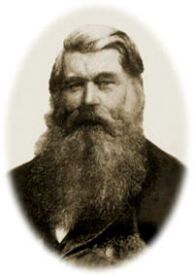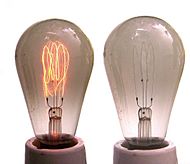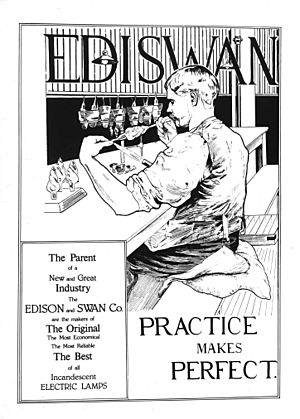Joseph Swan facts for kids
Quick facts for kids
Sir Joseph Wilson Swan
|
|
|---|---|

Photograph of Swan, circa 1900
|
|
| Born |
Joseph Wilson Swan
31 October 1828 |
| Died | 27 May 1914 (aged 85) Warlingham, Surrey, England
|
| Nationality | British |
| Known for | Incandescent light bulb Photographic process |
| Awards | Hughes Medal (1904) Albert Medal (1906) |
| Scientific career | |
| Fields | Physics, Chemistry |
Sir Joseph Wilson Swan (born October 31, 1828, died May 27, 1914) was a smart English scientist and inventor. He is famous for helping to invent the light bulb. He also provided the first electric lights for homes and public places. For example, he lit up the Savoy Theatre in London in 1881.
King Edward VII made him a 'Sir' in 1904. He also won important awards, like the Hughes Medal. France gave him their highest honor, the Legion of Honour, in 1881. This was when his inventions were shown at a big electricity fair in Paris. His lights even lit up the city!
Contents
Joseph Swan's Early Life
Joseph Wilson Swan was born in 1828 in Sunderland, England. His parents were John Swan and Isabella Cameron.
When he was young, Swan worked for a company that made medicines. He was always curious and loved to learn. He read many books at the Sunderland Library. He also went to lectures to learn more about science.
Later, Swan joined a chemical company in Newcastle upon Tyne. This company was owned by his brother-in-law, John Mawson. In 1846, Swan became a partner in the company. The company was later called Mawson, Swan, and Morgan.
Swan lived in a large house called Underhill in Gateshead. He did many of his experiments in the big glass room (conservatory) there. This house later became a school. Students could still see some of Swan's original electrical parts in the building.
Inventing the Electric Light Bulb
In 1850, Swan started working on a light bulb. He used thin pieces of carbonized paper inside a glass bulb with no air. By 1860, he had a working light bulb. But it did not last long because the vacuum was not good enough. Also, there was no strong power source.
In 1863, Swan designed a special pump to remove air from the bulb. This pump helped create a better vacuum. A good vacuum was important because it stopped the carbon from burning up.
In 1875, Swan tried again to make a better light bulb. He used a carbonized thread as the filament. This time, he had a much better vacuum. This meant there was almost no oxygen inside the bulb. So, the filament could glow very brightly without catching fire.
Swan showed his new light bulb to the public on December 18, 1878. He successfully showed it again on January 17, 1879. He had found a way to make electric light work! On February 3, 1879, he showed his working lamp to over 700 people.
Swan then worked on making an even better carbon filament. He found a way to treat cotton to make a strong, thin thread. He got a patent for this in 1880. After that, he started putting his light bulbs in homes and famous buildings in England.

His own house, Underhill, was the first house in the world to have working light bulbs. The Lit & Phil Library in Newcastle was the first public room lit by electric light. This happened during a lecture by Swan in October 1880. In 1881, he started his own company, The Swan Electric Light Company. This company began making light bulbs for sale.
The Savoy Theatre in London was the first public building in the world lit completely by electricity. Swan provided about 1,200 light bulbs for the theatre. The owner of the Savoy, Richard D'Oyly Carte, explained why he used electric light. He said that gas lights used up oxygen and made the theatre hot. Swan's electric lamps used no oxygen and made no heat.
The first private home, other than Swan's, to have his new light bulbs was Cragside. This was the home of his friend, Sir William Armstrong. Swan personally helped install the lights there in December 1880.
Swan also found a way to make strong, thin fibers from nitrocellulose. This process was used to make better filaments for his light bulbs. It was also used in the textile industry to make fabrics.
The first ship to use Swan's invention was The City of Richmond in June 1881. The Royal Navy also put his lights on their ships soon after. Electric lights were also used during the digging of the Severn Tunnel.
Swan also worked on electric safety lamps for miners. He showed his first one in 1881. Later, he made lamps with batteries. By 1886, the Edison-Swan Company made a mining lamp that was brighter than old flame lamps. However, it took many more years for electric lamps to be commonly used in mines.
Working with Thomas Edison
Joseph Swan and Thomas Edison both worked on incandescent light bulbs around the same time. Both patented their first successful lamps in 1879. Edison wanted his lamp to be part of a much bigger system. He wanted a long-lasting lamp that could work with a large electric power system. Swan's first lamp design was not quite right for this.
Because Swan had strong patents in Great Britain, his company and Edison's company joined together in 1883. They formed the Edison and Swan Electric Light Company, often called "Ediswan". This company sold lamps that used Swan's cellulose filament.
In 1886, Ediswan moved its production to a factory in North London. In 1916, Ediswan also started the first factory in the UK to make radio tubes. This area became an important center for the electronics industry.
Contributions to Photography
While working with wet photographic plates, Swan noticed something important. He saw that heat made the photographic material more sensitive. By 1871, he found a way to use dry plates. He also used a type of plastic instead of glass plates. This made photography much easier and more convenient.
Eight years later, he patented bromide paper. This type of paper is still used today for black-and-white photos.
In 1864, Swan also patented a process for making "carbon prints." This was a way to make very long-lasting photographs with many shades of gray.
Later Life and Honors
In 1894, Swan became a Fellow of the Royal Society, a very important science group. In 1898, he became the president of the Institution of Electrical Engineers. He also received an honorary degree from Durham University in 1901.
In 1904, he was knighted by King Edward VII. He also won the Hughes Medal and became an honorary member of the Royal Pharmaceutical Society.
In 1945, a ship was named SS Sir Joseph Swan to honor him.
Personal Life
Swan married Frances "Fanny" White in 1862. They had three children who lived: Cameron, Mary, and Joseph. Frances died in 1868. Later, he married Frances's younger sister, Hannah White, in 1871. They had five more children: Hilda, Frances, Kenneth, Percival, and Dorothy. His son, Sir Kenneth Rayden Swan, became an expert in patent law.
Sir Joseph Swan died in 1914 at his home in Surrey. He was buried in the churchyard at All Saints' Church. Many important people from science and engineering attended his funeral.
See also
 In Spanish: Joseph Wilson Swan para niños
In Spanish: Joseph Wilson Swan para niños




